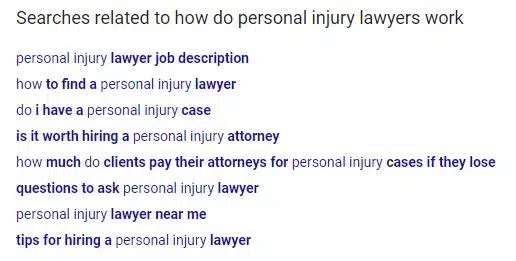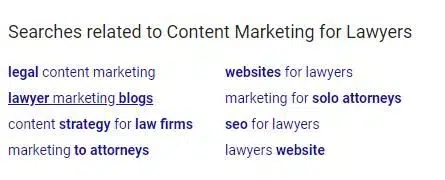As a lawyer or marketing director of a law firm, you have inevitably tried a number of tactics to drive in more cases. In this article, I am going to show you why content marketing for lawyers is integral to growth and why this strategy will be a mainstay in online marketing.

What is Content Marketing
Content marketing is the practice of creating highly valuable and relevant content with the goal of attracting new clients and retaining existing clients. When I say content, I am mostly referring to blogs, white papers, videos, or infographics.
These digital assets also enhance your brand’s reputation online, promote engagement, and position you as an authority in the legal field.
The best practice is broken into two different tasks: the creation of content and the marketing of content. All too often I see law firms get this wrong. Below is a list of common mistakes I see that need to be avoided:
A Low Quality Blog Post
Don’t blog just to blog. It’s not a checklist item. All of your blogs need to be high quality and at least 2,000 words. Create a blog strategy and be decisive about why you are creating a particular piece of content.
A Killer Piece of Content That’s Not Marketed
I see this all the time with blog postings and videos. If you wrote a great script and a professional camera crew filmed an amazing video, be sure to share your masterpiece with the world. I’ve seen really high quality videos just sitting on YouTube with only 20 views. Most of those views are probably the law firm’s staff.
I’ve also seen really well-written and high quality blog postings not ranking because they have zero links pointing to them. Trust me, publishers are always looking to link to an authoritative piece that enhances their article. So, don’t just create a great blog post, build some links to it!
Inconsistency
The production of content and the marketing of content should happen on the regular. Law firm marketing is competitive, but the consistent creation of blogs, videos, or white papers is an opportunity for you to beat out your competitors. Many law firms decided to roll out a monthly blog and then somewhere along the way just stopped writing new content. Maybe an employee left, a vendor was fired, or a budget was cut. Don’t let this happen to your firm! Roll out a strategy and stick to it every month. Later in this post, I’ll show the cost analysis and financial benefit.
How to Get Started
First and foremost, pick what type of content you are going to create. I recommend starting with blog content. From there, you can expand into video and creating white papers.
How to Create Topic Ideas
There are a few precursors to picking topic ideas. You will want to consult with your current search engine optimization (SEO) partner and ask for the following documents:
Keyword Research – Shows the keyword metrics like search volume and keyword difficulty scores. Look for keywords that are not assigned to any inner pages but could be used in an article topic.
On-Page SEO Document – At the bare minimum, this defines a keyword per page, title tag, H1 tag, and the meta description.
Current Tracking – Illustrates how certain keywords are ranking on Google, Yahoo, and Bing. There are many tools for tracking. At Rocket Pilots we use Agency Analytics and Local Dominator.
These documents and reports will help you avoid utilizing keywords that are already being used to rank your firm’s practice area pages. This is known as keyword cannibalization. If a competent professional, well versed in law firm internet marketing and lawyer SEO, has been working on the site, they probably have certain pages they are ranking or trying to rank in the search engine results page for pre-defined keywords.
Looking at the keyword research, on-page SEO document, and current keyword tracking should guide your decision when coming up with topic ideas.
Keyword research is important but not as important as it used to be for blogging. Search engines are more sophisticated than they used to be and are more capable of pairing content to not only the users query but also their intent.
If you are committed to writing long-form blog content consisting of 2,000 words or more, you will naturally write for user intent and incorporate a variety of useful keywords and phrases.
Let’s say you saw the phrase “how do personal injury lawyers work” in the keyword research and noticed your site was not ranking for it. That alone could be your article, but check out everything you can learn by doing more research.
Just by typing the phrase into Google, you will receive autocomplete suggestions. Some of those are great ideas for an article.
By conducting the search, you can also see the “people also ask” box.

More great topic ideas!
If you scroll down to the bottom of Google, you will see searches related to “how do personal injury lawyers work.”

More good ideas for articles or subheaders in the article of your current idea.
Here are a few more tactics you can utilize to come up with content ideas:
- Send out a company-wide email and solicit ideas from each attorney and staff member. Your clients are your best source of information, so encourage everyone to think of questions that clients typically ask.
- Send an email with a short survey to satisfied clients you have settled cases for in the past.
- Review other law firms content that is ranking, and think about how you can create a similar but much stronger piece.
- Type keywords into Quora and review all of the questions. One of those questions or an iteration of the question could be an excellent blog post topic.
- Use Ahrefs content explorer to review relevant content that has been shared on social media. If you’re going to get into link building, you will want an Ahrefs account anyway.

Creating your Content
Now that you have plenty of ideas to choose from, it’s time to execute. You can write the content yourself, hand it off to a staff member, or simply outsource to an SEO agency. Notice on the latter choice that I said SEO agency and not just a writer or ex-lawyer. That’s because your content not only needs to be written for users but also for rankings and shareability, and be perceived as a linkable asset by other publishers. Only a skilled marketer can properly setup this triple threat.
Does it need to be written by a lawyer?
Since I know you’re thinking it, I’ll proactively answer it. The answer is definitely not. I completely understand why this topic constantly comes up. The law is complex and a non J.D. can easily make a mistake and publish misinformation.
This problem is easily solved. Remember, the principal purpose of creating this content is for marketing. So, these blog postings are not the same content you would produce for a law book or anything academic in nature. They touch on the surface level of the actual law and aim to answer questions your average client would ask.
And lastly, simply proofread the content prior to publishing to make sure the article is free of grammar errors and properly represents your firm’s brand.
Uploading & Optimizing Your Content to Your Blog
You’ll need to upload the content to your blog and optimize with all the On-Page SEO best practices. This exercise is integral to rankings, so consider adopting a standard process for anyone adding new content to the site to follow.
Marketing Your Content

Okay, now that you have some guidance on content ideas, producing content, and optimizing your content, it’s time to jump into marketing your content.
From an SEO perspective, content and links pointing to your content are the top two Google ranking signals. So, naturally building links to your content should be at the top of your list.
1. Link Building
Starting off in link building is similar to launching a new sales department. Just like a salesperson needs prospects, a content marketer needs link prospects. Link prospects are qualified websites that could potentially link to your content. Ideally these are sites in the legal field that also produce content.
Your ideal prospect has a site relevant to the discipline of law you practice, tons of monthly traffic, and a Domain Authority of 30+.
Here are a few methods for link prospecting:
Review other law firms’ back link profiles. You can review competing sites in your local markets or non-competing sites that are ranking in large cities. You can review their link profiles in tools like Ahrefs or Majestic SEO. Export their back link profiles, sort by sites that have strong Domain Authority ratings, and add them to your database of link prospects.
Conduct a simple search for “best legal blogs.” I just did that and immediately found the following listicle with 38 law blogs: https://www.simplelegal.com/blog/top-in-house-legal-blogs-to-follow
Comb through it for link prospects.
Utilize Google’s Advanced Search Operators to refine results. Below are a few examples of operators you can use. From there, review the results and look for more prospects.
- “allintext: keyword.” – Returns results that contain your search query as text within a page’s content.
- “allintitle: keyword.” – Returns results that contain your query within the title.
- “allinurl: keyword.” – Returns results that contain your query within the URL.
Once you have built a sufficient database of link prospects, you’ll want to start reaching out via email to acquire links. The process is simple, but I’ll forewarn you, it will take organization and persistence to acquire new links.
Craft a few email pitches and reach out to site owners about “pitching” your piece of content. If well received, they will add a link to an existing blog post of theirs (which should be identified in your email outreach).
Do this over and over, and your rankings will skyrocket. Consequently, you will receive more traffic, phone calls, form submissions, and cases!
2. Social Sharing
Share your content on Facebook, Twitter, and Google Plus. But, take it a step further than a traditional upload. Create different snippets and posting titles, and share the piece multiple times. Not everyone clicks on that first upload, so switch up the posting language, and drive as much organic social media traffic as possible.
3. Run a Paid Campaign on Facebook

Organic reach on Facebook has been on the decline. Unless you have a huge fan base, you will mostly likely need to run a paid advertising campaign on Facebook in order to reach a material amount of potential clients. It’s pretty affordable to boost content for a brand awareness campaign.
4. Email Your List
If your firm has a database of emails, share your new piece of content with the subscriber base.
5. Turn It Into Video
Turn your blog into a video and share on YouTube, Vimeo, and Facebook. You can use a tool like Lumen 5 to transform a blog post into a video in just minutes.
6. Internal Linking
If you have a popular blog post on your site that already receives a good amount of traffic, add the link to your new piece of content.
7. Turn It Into A Whitepaper
The strategy of creating landing pages and driving paid traffic to download a lead magnet is still very effective. Turn your blog into an informative white paper, create a landing page, and drive some pay-per-click (PPC) traffic. Offer the content in exchange for their email. Add them to your email marketing campaign, and convert them to a client at a later date!
8. Use Outbrain or Taboola
These platforms are known as content discovery tools or native advertising platforms. Their content is often shown on big well-known publishers like Business Insider, NBC, and Bloomberg.
9. Quora
Find questions on Quora that your article naturally answers. Answer the question on Quora using a modified version of your blog post.
10. Influencer Marketing
Identify a prominent influencer in your industry and see if they will link to your article or share it on their social media accounts. You can efficiently identify influencers with BuzzStream or BuzzSumo. Before you flat out ask for a link or a share, you might want to think about building a relationship with the influencer. Try sharing their content, re-tweeting one of their tweets, commenting on a blog post, or connecting on LinkedIn.
The Financial Break Down
Many times I have engaged in the discussion with law firms over which is better, PPC or SEO. The argument for PPC is always the same. It’s faster, has the potential to provide immediate results, and it’s an on and off switch.
This is typically followed by an argument that points out that SEO takes time, trustworthy professionals are hard to find, and senior partners are eager for results.
All valid points!
For purposes of this example, I’m going to make the following assumptions:
- A $3,000 monthly budget for PPC
- Your average cost per click is $30
- A $3,000 monthly budget for content marketing
- Your content marketing tactic is exclusively Link Building
- The average case is $5k in revenue
Note: I am well aware the cost per click can range from $10 to $150. It depends if your handling misdemeanors in the middle of America or Mesothelioma cases in Los Angeles. I also know the average case can be smaller or much larger, but I had to pick a number for this example.
Month 1
PPC
You’re campaign is generating 100 clicks per month. Your site is converting traffic at 5%. This puts you in the top 25 percentile.
You close 20% of those 5 conversions (phone calls or form submissions) and land one case.
This yields a Return on Ad Spend of 167% ($5,000/$3,000).
Spending $3,000 to acquire $5,000 in revenue is a no brainer so your PPC campaign is a success.
Content Marketing – Link Building
Your cost for a high quality article of 2,000 words is $300.
You start with two pieces of content and invest $600.
You outsource the Link Building and invest the remaining $2,400, which concludes in 10 total links, 5 per article.
Your first month produces zero cases, as the search engines have not yet rewarded your new content.
Month 2
PPC
Same results as Month 1.
SEO
Again you invest in two more pieces of content and build five links to each piece of content. The search engines have still not moved your content from Month 1 to page one, and you’re not receiving any benefit yet from your content efforts.
Profit and Loss
PPC = +$4,000
SEO = -$6,000
Month 3
PPC
Same result as Month 1 and 2.
SEO
Again you invest in two more pieces of content and build five links to each piece of content.
Except now your content from Month 1 is ranking, and each article drove 100 visitors for a total of 200 new sessions from organic.
At the same conversion rate of 5%, you received ten conversions.
At a 20% close rate, you landed two clients yielding $10k in revenue.
Profit and Loss

PPC = +$6,000
SEO = +$1,000
Your Content Marketing efforts are now driving results. After three months, PPC is the clear winner, but Month 4 will reap the rewards of both Month 1 and Month 2 content efforts. This model builds in a 60-day ramp up for your content to rank and drive traffic. Of course this is variable, but the 60-day constant helps with this example.
Now that you see where this is headed, let’s just focus on the P & L for Months 4, 5, and 6.
Month 4 Profit and Loss
PPC = +$8,000
SEO = +$8,000
Here is the crossing point. It took us 4 months. But, SEO has now caught up to PPC.
Month 5 Profit and Loss
PPC = +$10,000
SEO = +$15,000
And after 5 months SEO has yielded an extra $5,000.
Month 6 Profit and Loss
PPC = +$12,000
SEO = +$22,000
After six months, the content marketing strategy has accumulated enough different pages ranking and driving over 100 unique sessions (per page) a month to exceed PPC by $10,000, almost doubling the profit from PPC.
Of course a disclaimer is in order. I don’t have a crystal ball that allows me to look into the future. But, I have worked on and reviewed several legal PPC campaigns, and I have deep experience in SEO. This exercise was intended to illustrate how significant the results can be of a properly managed content marketing campaign with a comparison of PPC included.
Just so you know there is no bias, I am an advocate of PPC and at Rocket Pilots we offer PPC Management as a service. But, too often I see law firms and business owners put off content because they want immediate results and are not educated on the power of SEO and content marketing.
Lastly, the main point I wanted you to see from this exercise was the residual impact content marketing can have on organic traffic. Yes, it will take time, patience, and budget. The hardest part will be the timeframe when you are investing in the initiative and not receiving any monetary benefit in return.
But, if you stay the course and commit to the process, you can reap huge rewards in perpetuity. It’s very much possible to drive traffic to your firm’s site from a piece of content that was created and marketed a year or two ago. Now how does that look on a financial model?!
Content Marketing Is a Long-Term Win for Law Firms
My goal with this article was to illustrate the importance of content marketing and to provide you with some actionable tactics your firm can implement immediately. I certainly hope you found them informative, and I can only hope you will put them to use.
Please leave your comments below. We’d love to know what content marketing strategies your team is currently utilizing.
Of course, if you would like professional consulting, do not hesitate to contact me directly for a complimentary consultation. I hope to hear from you soon!
